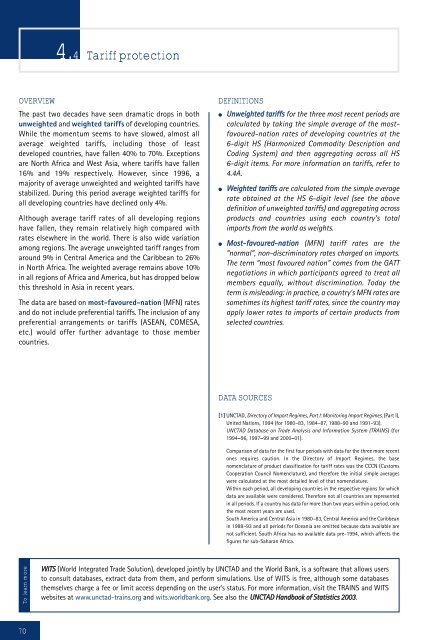Development and Globalization: - Unctad
Development and Globalization: - Unctad
Development and Globalization: - Unctad
You also want an ePaper? Increase the reach of your titles
YUMPU automatically turns print PDFs into web optimized ePapers that Google loves.
OVERVIEW DEFINITIONS<br />
The past two decades have seen dramatic drops in both<br />
unweighted <strong>and</strong> weighted tariffs of developing countries.<br />
While the momentum seems to have slowed, almost all<br />
average weighted tariffs, including those of least<br />
developed countries, have fallen 40% to 70%. Exceptions<br />
are North Africa <strong>and</strong> West Asia, where tariffs have fallen<br />
16% <strong>and</strong> 19% respectively. However, since 1996, a<br />
majority of average unweighted <strong>and</strong> weighted tariffs have<br />
stabilized. During this period average weighted tariffs for<br />
all developing countries have declined only 4%.<br />
Although average tariff rates of all developing regions<br />
have fallen, they remain relatively high compared with<br />
rates elsewhere in the world. There is also wide variation<br />
among regions. The average unweighted tariff ranges from<br />
around 9% in Central America <strong>and</strong> the Caribbean to 26%<br />
in North Africa. The weighted average remains above 10%<br />
in all regions of Africa <strong>and</strong> America, but has dropped below<br />
this threshold in Asia in recent years.<br />
The data are based on most-favoured-nation (MFN) rates<br />
<strong>and</strong> do not include preferential tariffs. The inclusion of any<br />
preferential arrangements or tariffs (ASEAN, COMESA,<br />
etc.) would offer further advantage to those member<br />
countries.<br />
To learn more<br />
70<br />
4.4 Tariff protection<br />
● Unweighted tariffs for the three most recent periods are<br />
calculated by taking the simple average of the mostfavoured-nation<br />
rates of developing countries at the<br />
6-digit HS (Harmonized Commodity Description <strong>and</strong><br />
Coding System) <strong>and</strong> then aggregating across all HS<br />
6-digit items. For more information on tariffs, refer to<br />
4.4A.<br />
● Weighted tariffs are calculated from the simple average<br />
rate obtained at the HS 6-digit level (see the above<br />
definition of unweighted tariffs) <strong>and</strong> aggregating across<br />
products <strong>and</strong> countries using each country’s total<br />
imports from the world as weights.<br />
● Most-favoured-nation (MFN) tariff rates are the<br />
“normal”, non-discriminatory rates charged on imports.<br />
The term “most favoured nation” comes from the GATT<br />
negotiations in which participants agreed to treat all<br />
members equally, without discrimination. Today the<br />
term is misleading: in practice, a country’s MFN rates are<br />
sometimes its highest tariff rates, since the country may<br />
apply lower rates to imports of certain products from<br />
selected countries.<br />
DATA SOURCES<br />
[1] UNCTAD, Directory of Import Regimes, Part I: Monitoring Import Regimes, (Part I),<br />
United Nations, 1994 (for 1980–83, 1984–87, 1988–90 <strong>and</strong> 1991–93).<br />
UNCTAD Database on Trade Analysis <strong>and</strong> Information System (TRAINS) (for<br />
1994–96, 1997–99 <strong>and</strong> 2000–01).<br />
Comparison of data for the first four periods with data for the three more recent<br />
ones requires caution. In the Directory of Import Regimes, the base<br />
nomenclature of product classification for tariff rates was the CCCN (Customs<br />
Cooperation Council Nomenclature), <strong>and</strong> therefore the initial simple averages<br />
were calculated at the most detailed level of that nomenclature.<br />
Within each period, all developing countries in the respective regions for which<br />
data are available were considered. Therefore not all countries are represented<br />
in all periods. If a country has data for more than two years within a period, only<br />
the most recent years are used.<br />
South America <strong>and</strong> Central Asia in 1980–83, Central America <strong>and</strong> the Caribbean<br />
in 1988–93 <strong>and</strong> all periods for Oceania are omitted because data available are<br />
not sufficient. South Africa has no available data pre-1994, which affects the<br />
figures for sub-Saharan Africa.<br />
WITS (World Integrated Trade Solution), developed jointly by UNCTAD <strong>and</strong> the World Bank, is a software that allows users<br />
to consult databases, extract data from them, <strong>and</strong> perform simulations. Use of WITS is free, although some databases<br />
themselves charge a fee or limit access depending on the user's status. For more information, visit the TRAINS <strong>and</strong> WITS<br />
websites at www.unctad-trains.org <strong>and</strong> wits.worldbank.org. See also the UNCTAD H<strong>and</strong>book of Statistics 2003.

















